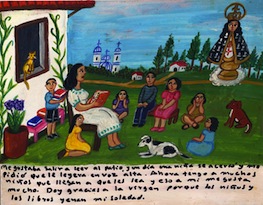
The almost completed Museum of the Hellenic Nobel Collection is in the Halandri suburb of Athens. It features the life work of Prof. Giorgio S. Marcou, who is the owner of an impressive collection of rare ex-voto retablos. Additionally he owns the Nobel collection and 162 smaller collections.
The Hellenic Nobel Museum is exhibiting just a small sample of its ex-voto retablos collection at the Lubaczow exhibition, which also features ex-votos from the collection of UNESCO-Hellas President Emeritus Nicos Papageorgiou. Similar exhibitions are also taking place in Latin America and Europe.
Ex-voto retablos are devotional or votive paintings and contain vivid colors. They are often painted on tin, leather or wood panels that offer thanks to Christ, the Virgin Mother or a saint for their protection in a threatening situation or intercession via prayer. They depict the situation often with an inscribed explanation of the event, date and location. They may be placed at a shrine as a votive offering or kept at home, displayed in a place of honor.
Widespread in Latin America, the ex-voto retablo or lamina, is a form of folk art that frequently uses iconography deriving from traditional art of the Catholic Church. It is similar in concept to the “tamata” of the Greek Orthodox Church and Eastern Orthodox Churches. Tamata (plural of tama), are usually small metal plaques, frequently of silver or gold. They usually have an embossed image symbolising the subject of the prayer or gratitude for a prayer answered, for which the plague is offered. Tamata are usually offered to an icon or church of a saint, Christ or the Virgin Mother.
According to Hellenic Folklore Research Center director Dr. Ekaterini Polymerou-Kamilaki, who organised the Greek participation in the exhibition, “tama” is the practice of placating the higher forces with the offer of material or other gifts (devotions); a practice that has been in use since primitive times.
(source: ana-mpa)
See all the latest news from Greece and the world at Greekreporter.com. Contact our newsroom to report an update or send your story, photos and videos. Follow GR on Google News and subscribe here to our daily email!



